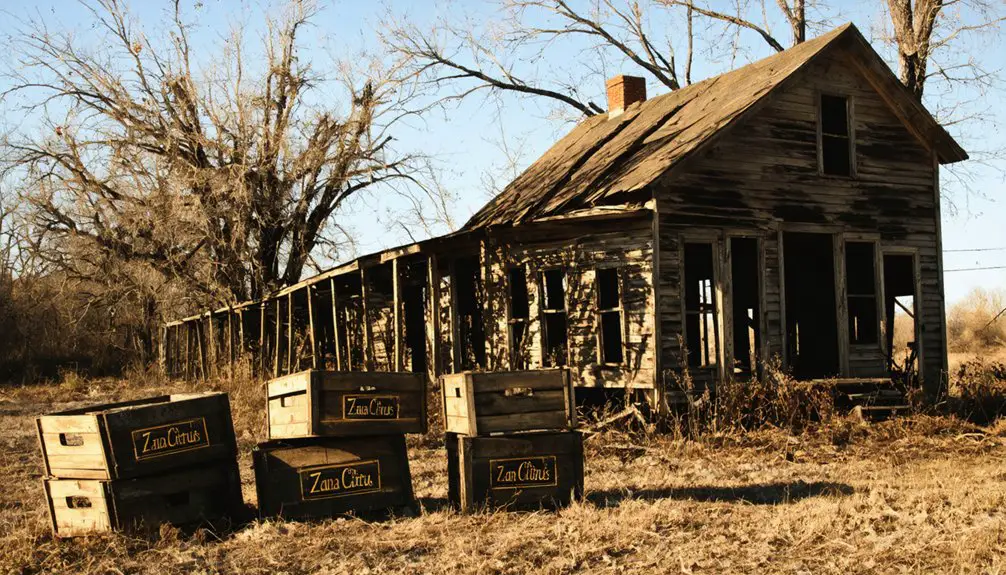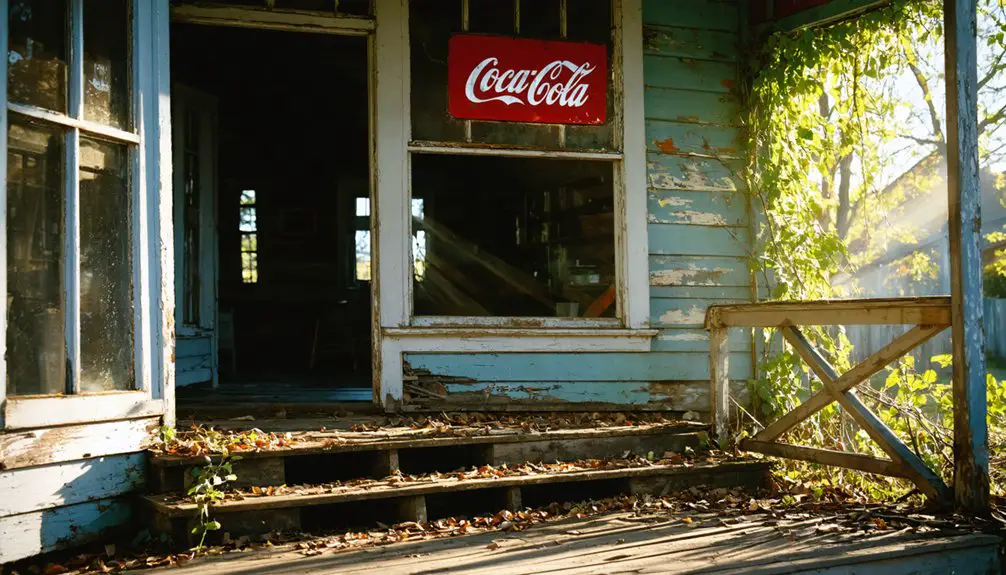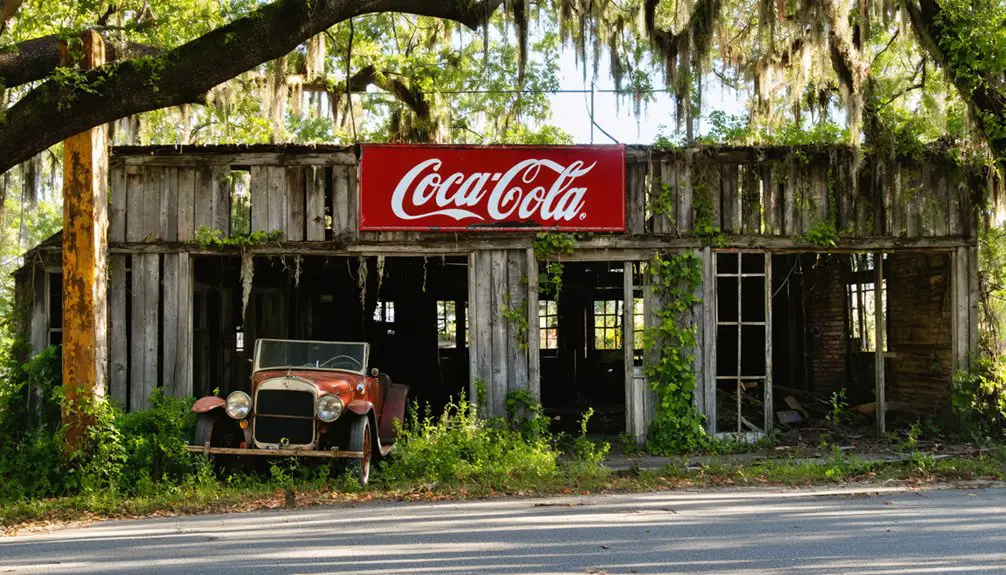You’ll find Zana’s remains in Martin County, Florida, where it emerged as a small settlement in the early 1900s along the Beeline Highway. The community thrived around the Seaboard Air Line Railroad, with citrus groves and turpentine operations driving its economy. After the Great Freeze of 1894-1895 destroyed 90% of its citrus trees, Zana declined rapidly. Today, the ghost town sits within Brady Ranch resort, where native vegetation has reclaimed most traces of this forgotten railroad stop.
Key Takeaways
- Zana was an early 20th-century settlement in Martin County, Florida, established along the Beeline Highway as a railroad stop.
- The town’s economy centered around the Seaboard Air Line Railroad, citrus groves, and turpentine operations.
- The Great Freeze of 1894-1895 devastated Zana’s citrus industry, causing economic collapse and massive population exodus.
- The site is now part of Brady Ranch resort, a private hunting ground where nature has reclaimed most of the original settlement.
- No original structures remain, and limited public access due to private ownership has left the ghost town largely undocumented.
Origins and Early Settlement
While little documentation exists about its founding, Zana emerged as a small settlement in Martin County, Florida, during the early 20th century. Named after a Roman goddess, the town appeared along the Beeline Highway and established itself as a railroad stop on the Seaboard Air Line Railroad.
The settlement patterns of Zana reflected typical rural Florida development of the era. You’ll find the community dynamics centered around railway services and local agricultural activities, though specific details about permanent residents and businesses remain scarce. Today, the area is part of Brady Ranch resort, a private game hunting destination. Similar to other Florida settlements, the town’s decline was hastened by resource depletion and lack of sustainable practices.
The town’s proximity to transportation routes likely influenced early settlers’ choice of location. Despite its presence on maps starting in the 1930s, Zana maintained a small, possibly transient population tied to the fortunes of the railroad and surrounding industries.
Life Along the Seaboard Air Line Railroad
As the Seaboard Air Line Railroad established its presence in Zana during the early 20th century, the railway became the community’s economic and social backbone.
The railroad culture touched every aspect of daily life, with train schedules dictating the rhythm of work and social activities. You’d find freight trains carrying timber, minerals, and local produce to northern markets, while passenger services connected you to Florida’s major cities and the Northeast. Marketed as The Route of Courteous Service, the railroad emphasized quality hospitality for both freight and passenger customers. The historic Orange Blossom Special train brought distinguished visitors and celebrations to communities along the line in 1927.
Train whistles and timetables set the pace of life, as freight and passengers flowed through Zana’s bustling railway hub.
The railroad’s influence created crucial community connections through its infrastructure of depots, maintenance facilities, and supply stores. You could ship your citrus harvest, catch a train for business in Jacksonville, or welcome visitors from distant regions.
This connectivity helped Zana thrive, as the SAL’s reliable transport services sustained local industries and kept the town’s population steady through the 1920s.
Agricultural Foundations and Economy
In Zana’s early development, you’d find citrus groves flourishing alongside the Seaboard Air Line Railroad’s tracks, which provided essential shipping routes to northern markets.
The railroad’s presence sparked the expansion of local turpentine operations, as pine forests surrounding Zana offered abundant resources for naval stores production. Similar to early Palm Beach County farmers who made significant profits from successful crop shipments, the railroad access was crucial for Zana’s agricultural economy.
The area’s historical documentation remains preserved through unique digital materials maintained by regional archives and institutions.
Citrus Grove Development
The roots of Florida’s citrus industry trace back to Native American settlers who first introduced citrus seeds near waterways, leading to the establishment of commercial groves on Merritt Island in 1818. The introduction of citrus into Florida occurred during the early Spanish exploration period between 1513 and 1565. The devastating Great Freeze of 1835 forced many growers to seek warmer locations for cultivation.
You’ll find that citrus varieties expanded considerably when General Sanford developed the Valencia orange in the 1870s, while early grove management practices focused on grafting and wide-spaced planting to accommodate sandy soils.
- Native seedlings were topworked into sweet orange varieties along the Indian River
- Local families like Overstreet, Bass, and Barber established groves near waterways for easy transport
- Grapefruit trees were planted 30ft apart to allow for extensive root systems
- Early groves didn’t rely on irrigation, instead depending on natural rainfall
- Grove density increased from 38 trees per acre in 1915 to 92 by 1960
Railroad Shipping Routes
When construction crews completed the Florida Railroad in 1861, they established an essential cross-peninsula shipping route connecting Fernandina on the Atlantic coast to Cedar Key on the Gulf coast.
You’d find this railroad expansion cutting approximately 800 miles off dangerous shipping routes around Florida’s southern tip, while creating significant economic corridors through towns like Baldwin, Waldo, and Gainesville.
The 5ft gauge line connected communities across Florida’s northern region, offering reliable transportation services.
Similar to the South Florida Railroad Company established in 1878, freight transportation on this line prioritized commercial products, particularly agricultural goods, over passenger service.
You could see how the railroad’s establishment transformed the region’s farming potential by providing year-round access to distant markets. The rail network reduced handling times and losses compared to ocean shipping, while supporting new agricultural communities that sprung up around railroad depots.
This infrastructure proved essential for transporting bulk materials like dynamite for land clearing and lime for soil treatment.
Turpentine Industry Impact
Among Florida’s earliest agricultural-industrial enterprises, turpentine production shaped both economic development and social structures throughout the mid-1800s.
You’ll find that turpentine extraction became a dominant force in northern Florida, transforming vast pine forests into industrial zones while relying heavily on exploited labor, particularly African American workers trapped in a system of convict leasing and vagrancy laws.
- Primitive camps housed workers in isolated settlements
- “Cat faces” carved into pine trees yielded valuable sap
- Clay “hery cups” replaced inefficient collection boxes in 1902
- Processing required skilled manual labor for distillation
- Large landowners controlled extensive turpentine operations
The industry’s decline began in the 1920s as steel ships and synthetic alternatives replaced traditional naval stores, marking the end of turpentine’s economic dominance and its legacy of labor exploitation.
The Great Freeze’s Devastating Impact

Your bustling citrus community’s agricultural dreams froze solid when temperatures plunged to devastating lows during the Great Freeze of 1894-1895, destroying more than 90% of Zana’s citrus trees and causing land values to plummet from $1,000 to just $10 per acre.
The economic devastation rippled through the entire region as farmers lost their primary source of income, transportation companies suffered significant losses, and local businesses struggled to survive.
Unable to weather the seven-year wait for new trees to mature and lacking financial resources to rebuild, many of Zana’s residents abandoned their properties and joined the mass exodus westward, leaving their once-prosperous town to fade into history.
Agricultural Dreams Destroyed
Before the devastating Great Freeze of 1894-1895, Florida’s citrus industry thrived across the northern regions of the state, producing approximately six million boxes of fruit annually.
You’d find bustling groves stretching from St. Augustine to Jacksonville, with the renowned Dummett grove leading the way in quality fruit production.
The citrus industry’s agricultural resilience had previously weathered challenging times, including the 1835 freeze.
- Temperatures plummeted to a bone-chilling 7 degrees
- December 1894’s initial freeze damaged crops but spared mature trees
- February 1895’s second freeze split tree trunks and destroyed entire groves
- Farmers watched helplessly as their fruit crops were completely destroyed
- The catastrophic events forced many growers to abandon their land entirely
The double freeze proved too severe for even the hardiest farmers, crushing dreams of agricultural prosperity in northern Florida.
Economic Ripple Effects
The devastating Great Freeze of 1894-1895 triggered an unprecedented economic collapse across Florida’s citrus regions, as production plummeted from six million boxes to a mere 100,000 boxes in a single season.
You’d have witnessed land values nosediving from $1,000 to just $10 per acre, devastating local wealth and stability.
The freeze’s aftermath created a ripple effect you couldn’t escape. Farm laborers and packing house workers lost their jobs, while small growers couldn’t afford to replant.
Towns like Zana saw their populations dwindle as labor migration intensified, draining skilled workers from the area. Business activity ground to a halt as consumer spending dried up.
Transport companies, equipment suppliers, and packing facilities faced severe downturns, leading to a complete restructuring of Florida’s agricultural economy.
Mass Population Exodus
Massive waves of displaced farmers and workers fled their homes in the wake of the 1894-1895 Great Freeze, marking one of Florida’s most dramatic population shifts. The devastating freeze transformed migration patterns across the state, as you’d witness entire communities dissolving while others emerged further south.
Places like Earnestville completely disappeared from the map, while Miami and Homestead saw unprecedented growth.
- You’d find formerly thriving citrus communities becoming ghost towns virtually overnight.
- Farmers faced the choice between relocating south or leaving Florida entirely for western states.
- Both white and Black farming communities saw their community resilience tested by forced relocation.
- South Florida’s population surged as farmers sought freeze-resistant agricultural zones.
- The Indian River region and Palm Beach County became new hubs for displaced agricultural workers.
Ghost Town Transformation

Since its abandonment as a railroad settlement, Zana’s transformation into private hunting grounds marks a dramatic shift in land use and accessibility.
You’ll find the ghost town evolution has followed a path common to many Florida ghost towns, where nature gradually reclaims human-built environments. The site’s ecological restoration showcases native vegetation like saw palmettos and scrub pines, which have overtaken the former townsite.
Today, as part of Brady Ranch, Zana’s land serves primarily as a private game hunting resort.
You won’t find any commercial development or preserved structures – unlike some ghost towns that became state parks. The private ownership limits public access and historical preservation efforts, while natural succession continues to blur the boundaries between what was once a bustling railroad town and the surrounding wilderness.
Historical Legacy in Maps and Documents
While Zana’s physical remnants have largely vanished, you’ll find its historical footprint preserved in maps dating back to the 1930s.
The town’s cartographic analysis reveals its strategic position along the Seaboard Air Line Railroad and the Beeline Highway, highlighting its historical significance in Florida’s transportation network.
Named after a Roman goddess, Zana’s presence on maps has outlasted its physical existence, particularly in relation to the Brady Ranch area.
Though Zana’s physical traces have faded away, its name endures on maps near Brady Ranch, echoing its divine namesake.
- Appeared consistently on railroad route maps and timetables as a minor but documented stop
- Named location persists on contemporary maps despite ghost town status
- Positioned as a waypoint along vital east-west routes in Martin County
- Mapped in connection with the Brady Ranch property area
- Historical maps reflect its evolution from railroad stop to vanished settlement
Comparing Zana to Other Lost Florida Towns

Unlike many of Florida’s documented ghost towns, Zana stands apart due to its limited historical footprint and minimal preserved ruins.
While places like Fort Dade and Eldora boast significant structures and compelling ghost town narratives, you’ll find Zana’s remains largely hidden on private Brady Ranch property.
Other lost towns often tell clear stories of decline through natural disasters, military abandonment, or economic shifts.
Yet Zana’s story remains mysteriously sparse, with few records of its railroad town origins or community life.
You won’t discover the tourist-friendly hiking trails or restored buildings that characterize Florida’s better-known ghost towns.
Instead, Zana comparisons reveal a stark contrast – while its name persists on maps, its physical and cultural legacy has nearly vanished into the inland Florida landscape.
Preservation Status and Modern Significance
Today, Zana’s preservation status reflects its near-complete disappearance from Florida’s historical landscape.
You’ll find most of the former townsite on Brady Ranch, a private hunting resort that limits public access. The town faces significant preservation challenges, with no active restoration projects and minimal remains of its original structures.
While Zana’s cultural significance stems from its unique name and role in Florida’s railroad development, its obscurity has left it largely forgotten.
Despite its significance in Florida’s railroad history, Zana has faded into obscurity, leaving behind little more than its distinctive name.
- Nearly all physical structures have vanished from the site
- Private ownership restricts access to most of the original town footprint
- No historical markers or interpretive signage exist on-site
- Natural reclamation continues unchecked for decades
- The site appears on maps but lacks detailed documentation
Frequently Asked Questions
What Role Did Native Americans Play in the Zana Area?
You’ll find Native tribes like Seminole, Timucua, and Calusa established significant cultural influence through ceremonial sites, hunting grounds, and settlements before European colonization disrupted their traditional way of life.
Were There Any Notable Crimes or Incidents in Zana’s History?
Precious public records persistently prove problematic – you won’t find documented Zana crimes or incidents in historical archives. The town’s small size and private ownership today limit investigation of potential past events.
What Happened to the Buildings and Structures After Residents Left?
You’ll find most buildings naturally deteriorated in Florida’s humid climate after abandonment, with no historical preservation efforts saving them. The structures eventually vanished as the land transformed into today’s private hunting ranch.
Did Any Famous People or Historical Figures Visit Zana?
Along the quiet rail tracks where whispers of the past linger, you won’t find records of any famous visitors or historical figures stopping in Zana – its significance remained purely local.
What Was the Peak Population of Zana During Its Existence?
You won’t find official records of Zana’s peak population. With limited Zana demographics and a railroad-based Zana economy, the small settlement never grew large enough for census inclusion.
References
- https://cccourthouse.org/wp-content/uploads/2023/12/Ghost-towns-and-Cemeteries-of-Citrus-County.pdf
- https://freepages.history.rootsweb.com/~gtusa/usa/fl.htm
- https://patchproflorida.com/blog/the-fascinating-history-of-floridas-ghost-towns/
- https://www.palatkadailynews.com/local-around-putnam/exploring-putnam-countys-past-look-local-ghost-towns
- https://www.ghosttowns.com/states/fl/zana.html
- https://ghosttownadventures.wordpress.com/2021/06/20/zana/
- https://www.emeraldcoastmagazine.com/ghost-towns-of-west-florida/
- https://www.journaloffloridastudies.org/0102ghosttowns.html
- https://en.wikipedia.org/wiki/Seaboard_Air_Line_Railroad
- https://en.wikipedia.org/wiki/Seaboard–All_Florida_Railway



